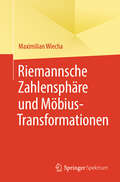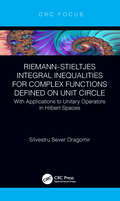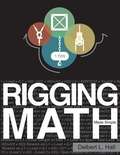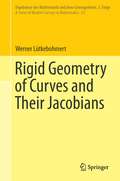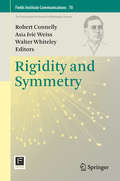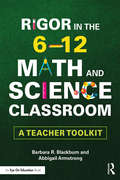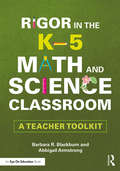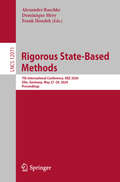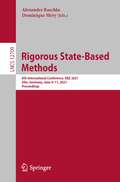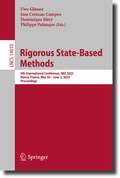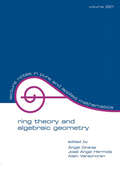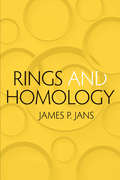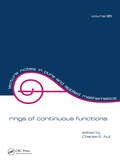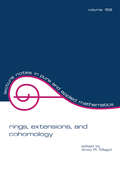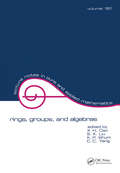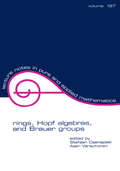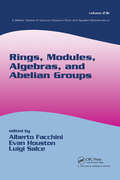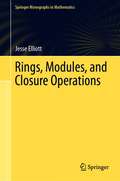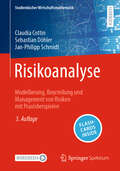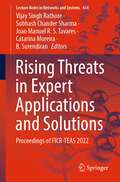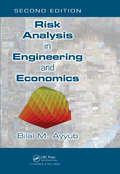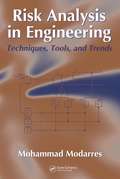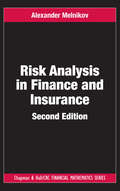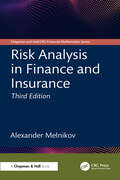- Table View
- List View
Riemannsche Zahlensphäre und Möbius-Transformationen
by Maximilian WiechaIn diesem Buch wird der Punkt Unendlich zum Greifen nahe! Mit seiner berühmten Zahlenkugel fand Riemann eine Darstellung, in die der „unendlich ferne Punkt“ völlig gleichberechtigt zu den Punkten steht, die durch endliche Zahlenwerte beschrieben werden. Neben der Konstruktionsanleitung dieser Kugel widmen wir uns ausführlich den topologischen Grundlagen der erweiterten komplexen Ebene und den Eigenschaften der stereographischen Projektion. Zudem wird der Bezug zu einem wichtigen Abbildungstypen der Funktionentheorie hergestellt: den Möbius-Transformationen. Möbius-Transformationen bilden die Automorphismen der erweiterten Eben und kommen beispielsweise in der speziellen Relativitätstheorie und der Elektrotechnik („Smith-Diagramm“) zur Anwendung. Die als Lehrskript verfasste Lektüre umfasst das Fundament für das Verständnis beider Themen und beleuchtet ihre Verbindung. Sie enthält den ausführlich ausgearbeiteten Beweis zum berühmten YouTube-Video „Möbius Transformations Revealed“ (2008) von Arnold und Rogness und richtet sich an Interessierte der Mathematik, die bereits mit den Grundlagen der reellen Analysis, linearen Algebra und Differentialgeometrie vertraut sind. Der Autor Maximilian Wiecha studierte an der TU Braunschweig Chemie und Mathematik auf gymnasiales Lehramt. Im Laufe seines Studiums vertiefte er beide Fachrichtungen und beschäftigte sich u. a. mit der selektiven Synthese unsymmetrischer Diboran(IV)-Derivate. Neben seiner Leidenschaft für anorganische und physikalische Chemie, gehören die höhere Mathematik. Sein Interesse liegt auf Forschung und universitärer Lehre.
Riemann–Stieltjes Integral Inequalities for Complex Functions Defined on Unit Circle: with Applications to Unitary Operators in Hilbert Spaces
by Silvestru Sever DragomirThe main aim of this book is to present several results related to functions of unitary operators on complex Hilbert spaces obtained, by the author in a sequence of recent research papers. The fundamental tools to obtain these results are provided by some new Riemann-Stieltjes integral inequalities of continuous integrands on the complex unit circle and integrators of bounded variation. Features All the results presented are completely proved and the original references where they have been firstly obtained are mentioned Intended for use by both researchers in various fields of Linear Operator Theory and Mathematical Inequalities, as well as by postgraduate students and scientists applying inequalities in their specific areas Provides new emphasis to mathematical inequalities, approximation theory and numerical analysis in a simple, friendly and well-digested manner. About the Author Silvestru Sever Dragomir is Professor and Chair of Mathematical Inequalities at the College of Engineering & Science, Victoria University, Melbourne, Australia. He is the author of many research papers and several books on Mathematical Inequalities and their Applications. He also chairs the international Research Group in Mathematical Inequalities and Applications (RGMIA). For details, see https://rgmia.org/index.php.
Rigging Math Made Simple
by Delbert HallThis book breaks down complex entertainment rigging (theatre and arena) calculations and makes them easy to understand. It also provides hints for remembering many rigging formulas. It is a great resource for anyone studying for either ETCP rigging exam, and includes an explanation of the equations found on the ETCP Certified Rigger - Formula Table. The third edition has a greatly expanded section on arena rigging, as well as more material and appendices for theatrical rigging. Also, this edition has links to even more free downloads of Excel workbooks for arena rigging. Beginning riggers will find this an excellent textbook and experience riggers will find it as a great reference book.
Rigid Cohomology over Laurent Series Fields
by Christopher Lazda Ambrus PálIn this monograph, the authors develop a new theory of p-adiccohomology for varieties over Laurent series fields in positive characteristic,based on Berthelot's theory of rigid cohomology. Many major fundamentalproperties of these cohomology groups are proven, such as finite dimensionalityand cohomological descent, as well asinterpretations in terms of Monsky-Washnitzer cohomology and Le Stum'soverconvergent site. Applications of this new theory to arithmetic questions, such as l-independenceand the weight monodromy conjecture, are also discussed. The construction of these cohomology groups, analogous to theGalois representations associated tovarieties over local fields in mixed characteristic, fills a major gap in the study of arithmetic cohomology theoriesover function fields. By extending the scope of existing methods, the results presented here also serve as a firststep towards a more general theory of p-adic cohomology overnon-perfect ground fields. Rigid Cohomology over Laurent Series Fields will provide a useful tool for anyone interested in thearithmetic of varieties over local fields of positive characteristic. Appendices on important background material such as rigid cohomology and adicspaces make it as self-contained as possible, and an ideal starting point forgraduate students looking to explore aspects of the classical theory of rigidcohomology and with an eye towards future research in the subject.
Rigid Geometry of Curves and Their Jacobians
by Werner LütkebohmertThis book presents some of the most important aspects of rigid geometry, namely its applications to the study of smooth algebraic curves, of their Jacobians, and of abelian varieties - all of them defined over a complete non-archimedean valued field. The text starts with a survey of the foundation of rigid geometry, and then focuses on a detailed treatment of the applications. In the case of curves with split rational reduction there is a complete analogue to the fascinating theory of Riemann surfaces. In the case of proper smooth group varieties the uniformization and the construction of abelian varieties are treated in detail. Rigid geometry was established by John Tate and was enriched by a formal algebraic approach launched by Michel Raynaud. It has proved as a means to illustrate the geometric ideas behind the abstract methods of formal algebraic geometry as used by Mumford and Faltings. This book should be of great use to students wishing to enter this field, as well as those already working in it.
Rigidity and Symmetry
by Robert Connelly Asia Ivić Weiss Walter WhiteleyThis book contains recent contributions to the fields of rigidity and symmetry with two primary focuses: to present the mathematically rigorous treatment of rigidity of structures and to explore the interaction of geometry, algebra and combinatorics. Contributions present recent trends and advances in discrete geometry, particularly in the theory of polytopes. The rapid development of abstract polytope theory has resulted in a rich theory featuring an attractive interplay of methods and tools from discrete geometry, group theory, classical geometry, hyperbolic geometry and topology. Overall, the book shows how researchers from diverse backgrounds explore connections among the various discrete structures with symmetry as the unifying theme The volume will be a valuable source as an introduction to the ideas of both combinatorial and geometric rigidity theory and its applications, incorporating the surprising impact of symmetry. It will appeal to students at both the advanced undergraduate and graduate levels, as well as post docs, structural engineers and chemists.
Rigor in the 6–12 Math and Science Classroom: A Teacher Toolkit
by Barbara R. Blackburn Abbigail ArmstrongLearn how to incorporate rigorous activities in your math or science classroom and help students reach higher levels of learning. Expert educators and consultants Barbara R. Blackburn and Abbigail Armstrong offer a practical framework for understanding rigor and provide specialized examples for middle and high school math and science teachers. Topics covered include: Creating a rigorous environment High expectations Support and scaffolding Demonstration of learning Assessing student progress Collaborating with colleagues The book comes with classroom-ready tools, offered in the book and as free eResources on our website at www.routledge.com/9781138302716.
Rigor in the K–5 Math and Science Classroom: A Teacher Toolkit
by Barbara R. Blackburn Abbigail ArmstrongLearn how to incorporate rigorous activities in your math or science classroom and help students reach higher levels of learning. Expert educators and consultants Barbara R. Blackburn and Abbigail Armstrong offer a practical framework for understanding rigor and provide specialized examples for elementary math and science teachers. Topics covered include: Creating a rigorous environment High expectations Support and scaffolding Demonstration of learning Assessing student progress Collaborating with colleagues The book comes with classroom-ready tools, offered in the book and as free eResources on our website at www.routledge.com/9780367343194.
Rigorous State-Based Methods: 7th International Conference, ABZ 2020, Ulm, Germany, May 27–29, 2020, Proceedings (Lecture Notes in Computer Science #12071)
by Alexander Raschke Dominique Méry Frank HoudekThis book constitutes the refereed proceedings of the 7th International Conference on Rigorous State-Based Methods, ABZ 2020, which was due to be held in Ulm, Germany, in May 2020. The conference was cancelled due to the COVID-19 pandemic. The 12 full papers and 9 short papers were carefully reviewed and selected from 61 submissions. They are presented in this volume together with 2 invited papers, 6 PhD-Symposium-contributions, as well as the case study and 6 accepted papers outlining solutions to it. The papers are organized in the following sections: keynotes and invited papers; regular research articles; short articles; articles contributing to the case study; short articles of the PhD-symposium (work in progress).
Rigorous State-Based Methods: 8th International Conference, ABZ 2021, Ulm, Germany, June 9–11, 2021, Proceedings (Lecture Notes in Computer Science #12709)
by Alexander Raschke Dominique MéryThis book constitutes the proceedings of the 8th International Conference on Rigorous State-Based Methods, ABZ 2021, which was planned to take place in Ulm, Germany, during June 6-11, 2021. The conference changed to an online format due to the COVID-19 pandemic. The 6 full and 8 short papers included in this volume were carefully reviewed and selected from 18 submissions. The proceedings also include 3 PhD symposium contributions. They deal with state-based and machine-based formal methods, mainly Abstract State Machines (ASM), Alloy, B, TLA+, VDM, and Z.
Rigorous State-Based Methods: 9th International Conference, ABZ 2023, Nancy, France, May 30–June 2, 2023, Proceedings (Lecture Notes in Computer Science #14010)
by Philippe Palanque Uwe Glässer Dominique Méry Jose Creissac CamposThis book constitutes the refereed proceedings of the 9th International Conference on Rigorous State-Based Methods, ABZ 2023, held in Nancy, France, in May 2023. The 12 full and 7 short papers included in this volume were carefully reviewed and selected from 47 submissions. The proceedings also include 4 PhD symposium contributions. They deal with state-based and machine-based formal methods, mainly Abstract State Machines (ASM), Alloy, B, TLA+, VDM, and Z.
Ring Theory And Algebraic Geometry
by Angel Granja Jose Angel Hermida Alain VerschorenFocuses on the interaction between algebra and algebraic geometry, including high-level research papers and surveys contributed by over 40 top specialists representing more than 15 countries worldwide. Describes abelian groups and lattices, algebras and binomial ideals, cones and fans, affine and projective algebraic varieties, simplicial and cellular complexes, polytopes, and arithmetics.
Rings and Homology (Dover Books on Mathematics)
by James P. JansThis concise text is geared toward students of mathematics who have completed a basic college course in algebra. Combining material on ring structure and homological algebra, the treatment offers advanced undergraduate and graduate students practice in the techniques of both areas. After a brief review of basic concepts, the text proceeds to an examination of ring structure, with particular attention to the structure of semisimple rings with minimum condition. Subsequent chapters develop certain elementary homological theories, introducing the functor Ext and exploring the various projective dimensions, global dimension, and duality theory. Each chapter concludes with a set of exercises.
Rings of Continuous Function
by Charles E. AullThis book contains papers on algebra, functional analysis, and general topology, with a strong interaction with set theoretic axioms and involvement with category theory, presented in the special session on Rings of Continuous Functions held in 1982 in Cincinnati, Ohio.
Rings, Extensions, and Cohomology: Proceedings Of The Conference On The Occasion Of The Retirement Of Daniel Zelinsky (Lecture Notes In Pure And Applied Mathematics Ser.)
by Andy R. Magid"Presenting the proceedings of a conference held recently at Northwestern University, Evanston, Illinois, on the occasion of the retirement of noted mathematician Daniel Zelinsky, this novel reference provides up-to-date coverage of topics in commutative and noncommutative ring extensions, especially those involving issues of separability, Galois theory, and cohomology."
Rings, Groups, and Algebras
by X. H. Cao; S. X. Liu; K. P. Shum; C. C. Yang"Integrates and summarizes the most significant developments made by Chinese mathematicians in rings, groups, and algebras since the 1950s. Presents both survey articles and recent research results. Examines important topics in Hopf algebra, representation theory, semigroups, finite groups, homology algebra, module theory, valuation theory, and more."
Rings, Hopf Algebras, and Brauer Groups
by Stefaan Caenepeel; Alain Verschoren"Based on papers presented at a recent international conference on algebra and algebraic geometry held jointly in Antwerp and Brussels, Belgium. Presents both survey and research articles featuring new results from the intersection of algebra and geometry. "
Rings, Modules, Algebras, and Abelian Groups (Lecture Notes in Pure and Applied Mathematics)
by Evan Houston Luigi Salce Alberta FacchiniRings, Modules, Algebras, and Abelian Groups summarizes the proceedings of a recent algebraic conference held at Venice International University in Italy. Surveying the most influential developments in the field, this reference reviews the latest research on Abelian groups, algebras and their representations, module and ring theory, and topological
Rings, Modules, and Closure Operations (Springer Monographs in Mathematics)
by Jesse ElliottThis book presents a systematic exposition of the various applications of closure operations in commutative and noncommutative algebra. In addition to further advancing multiplicative ideal theory, the book opens doors to the various uses of closure operations in the study of rings and modules, with emphasis on commutative rings and ideals. Several examples, counterexamples, and exercises further enrich the discussion and lend additional flexibility to the way in which the book is used, i.e., monograph or textbook for advanced topics courses.
Risikoanalyse: Modellierung, Beurteilung und Management von Risiken mit Praxisbeispielen (Studienbücher Wirtschaftsmathematik)
by Claudia Cottin Sebastian Döhler Jan-Philipp SchmidtDieses Lehrbuch stellt mathematische Methoden der Risikomodellierung und -analyse anwendungsorientiert dar. Finanz- und versicherungsmathematische Aspekte werden hier gemeinsam behandelt, etwa hinsichtlich Simulationsmethoden, Risikokennzahlen und Risikoaggregation. So bildet das Buch eine fundierte Grundlage für quantitativ orientiertes Risikomanagement in verschiedensten Bereichen und weckt das Verständnis für Zusammenhänge, die in spartenspezifischer Literatur oft nicht angesprochen werden. Zahlreiche Beispiele stellen immer wieder den konkreten Bezug zur Praxis her. Das Buch wendet sich an Studierende der Wirtschaftsmathematik, der Wirtschaftswissenschaften und des Wirtschaftsingenieurwesens im Bachelor- und Master-Studium sowie an Berufstätige in Banken, Versicherungen, Wirtschaftsunternehmen und Beratungsfirmen. Für die 3. Auflage wurden Aktualisierungen und Korrekturen vorgenommen sowie gut 180 digitale Flashcards erstellt, mit denen das Verständnis der Buchinhalte via kostenfreier App oder direkt im Browser überprüft werden kann.
Rising Threats in Expert Applications and Solutions: Proceedings of FICR-TEAS 2022 (Lecture Notes in Networks and Systems #434)
by Vijay Singh Rathore Subhash Chander Sharma Joao Manuel R. S. Tavares Catarina Moreira B. SurendiranThe book presents high-quality, peer-reviewed papers from the FICR International Conference on Rising Threats in Expert Applications and Solutions 2022 organized by IIS (Deemed to be University), Jaipur, Rajasthan, India, during January 7–8, 2022. The volume is a collection of innovative ideas from researchers, scientists, academicians, industry professionals, and students. The book covers a variety of topics, such as expert applications and artificial intelligence/machine learning; advance web technologies such as IoT, big data, cloud computing in expert applications; information and cyber security threats and solutions, multimedia applications in forensics, security and intelligence; advancements in app development; management practices for expert applications; and social and ethical aspects in expert applications through applied sciences.
Risk Analysis in Engineering and Economics
by Bilal M. AyyubRisk Analysis in Engineering and Economics is required reading for decision making under conditions of uncertainty. The author describes the fundamental concepts, techniques, and applications of the subject in a style tailored to meet the needs of students and practitioners of engineering, science, economics, and finance. Drawing on his extensive e
Risk Analysis in Engineering: Techniques, Tools, and Trends
by Mohammad ModarresBased on the author's 20 years of teaching, Risk Analysis in Engineering: Techniques, Tools, and Trends presents an engineering approach to probabilistic risk analysis (PRA). It emphasizes methods for comprehensive PRA studies, including techniques for risk management. The author assumes little or no prior knowledge of risk analysis on the p
Risk Analysis in Finance and Insurance
by Alexander MelnikovRisk Analysis in Finance and Insurance, Second Edition presents an accessible yet comprehensive introduction to the main concepts and methods that transform risk management into a quantitative science. Taking into account the interdisciplinary nature of risk analysis, the author discusses many important ideas from mathematics, finance, and actuaria
Risk Analysis in Finance and Insurance (Chapman and Hall/CRC Financial Mathematics Series)
by Alexander MelnikovRisk Analysis in Finance and Insurance, Third Edition presents an accessible yet comprehensive introduction to the main concepts and methods that transform risk management into a quantitative science. Considering the interdisciplinary nature of risk analysis, the author discusses many important ideas from stochastic analysis, mathematical finance and actuarial science in a simplified manner. He explores the interconnections among these disciplines and encourages readers toward further study of the subject. This edition continues to study risks associated with financial and insurance contracts, using an approach that estimates the value of future payments based on current financial, insurance, and other information.Features of the third edition 12 chapters instead of 8 of the 2nd editions. Two new chapters on Wiener process as a base for financial market modeling. Option pricing in the Bachelier model, the model of Black and Scholes, the Gram-Charlier model. American options and their pricing in the Black-Scholes model Several new notions, topics and results that are not reflected yet in other textbooks, and even in monographs (Binomial model with constraints, detailed exposition of quantile hedging technique, Conditional Value at Risk, Range of Value at Risk, applications to equity-linked life insurance) Can be regarded as a self-contained issue of courses on Mathematical Finance, Actuarial Science and Risk Management Replete with new exercises, problems, hints and solutions
